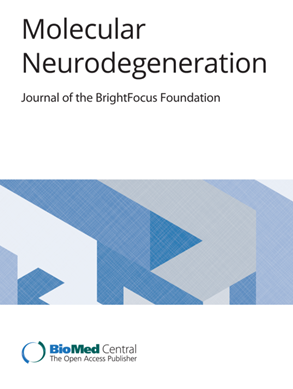Biomarkers and therapeutic strategies targeting microglia in neurodegenerative diseases: current status and future directions
IF 17.5
1区 医学
Q1 NEUROSCIENCES
引用次数: 0
Abstract
Recent advances in our understanding of non-cell-autonomous mechanisms in neurodegenerative diseases (NDDs) have highlighted microglial dysfunction as a core driver of disease progression. Conditions such as Alzheimer’s disease (AD), amyotrophic lateral sclerosis (ALS), Parkinson’s disease (PD), and frontotemporal dementia (FTD) share features of impaired microglial phagocytosis, chronic neuroinflammation, and metabolic dysregulation. These insights have prompted new therapeutic strategies targeting microglial function and emphasized the need for reliable biomarkers to monitor disease progression and treatment response. Well-established therapeutic targets, such as triggering receptor expressed on myeloid cells 2 (TREM2), progranulin (PGRN), and sortilin (SORT1), along with emerging candidates including LILRB4, P2Y6R, TAM receptors, and neuroinflammation-related markers, are discussed alongside novel blood, cerebrospinal fluid (CSF), and imaging biomarkers. Despite notable progress, many of these biomarkers remain restricted to preclinical studies and face translational challenges due to species-specific differences, lack of standardization, and clinical heterogeneity. Emerging technologies—including single-cell omics, spatial transcriptomics, and artificial intelligence (AI)-driven integration of multimodal data—offer new opportunities to align biomarker profiles with evolving disease states and improve patient stratification. Building on the model of companion diagnostics (CDx) in oncology, integrating multimodal biomarker strategies holds promise for guiding personalized interventions, improving clinical outcomes, and deepening our mechanistic understanding of microglial contributions across the neurodegenerative spectrum.神经退行性疾病中针对小胶质细胞的生物标志物和治疗策略:现状和未来方向
最近我们对神经退行性疾病(ndd)非细胞自主机制的理解有了新的进展,强调了小胶质细胞功能障碍是疾病进展的核心驱动因素。阿尔茨海默病(AD)、肌萎缩性侧索硬化症(ALS)、帕金森病(PD)和额颞叶痴呆(FTD)等疾病都具有小胶质细胞吞噬功能受损、慢性神经炎症和代谢失调的特征。这些发现促进了针对小胶质细胞功能的新治疗策略,并强调需要可靠的生物标志物来监测疾病进展和治疗反应。已建立的治疗靶点,如髓样细胞2 (TREM2),前颗粒蛋白(PGRN)和SORT1表达的触发受体,以及新兴的候选物,包括LILRB4, P2Y6R, TAM受体和神经炎症相关标志物,与新的血液,脑脊液(CSF)和成像生物标志物一起讨论。尽管取得了显著进展,但由于物种特异性差异、缺乏标准化和临床异质性,许多生物标志物仍然局限于临床前研究,并面临转化挑战。新兴技术——包括单细胞组学、空间转录组学和人工智能(AI)驱动的多模式数据集成——为将生物标志物谱与不断发展的疾病状态相结合并改善患者分层提供了新的机会。在肿瘤学伴随诊断(CDx)模型的基础上,整合多模式生物标志物策略有望指导个性化干预,改善临床结果,并加深我们对神经退行性谱系中小胶质细胞贡献的机制理解。
本文章由计算机程序翻译,如有差异,请以英文原文为准。
求助全文
约1分钟内获得全文
求助全文
来源期刊

Molecular Neurodegeneration
医学-神经科学
CiteScore
23.00
自引率
4.60%
发文量
78
审稿时长
6-12 weeks
期刊介绍:
Molecular Neurodegeneration, an open-access, peer-reviewed journal, comprehensively covers neurodegeneration research at the molecular and cellular levels.
Neurodegenerative diseases, such as Alzheimer's, Parkinson's, Huntington's, and prion diseases, fall under its purview. These disorders, often linked to advanced aging and characterized by varying degrees of dementia, pose a significant public health concern with the growing aging population. Recent strides in understanding the molecular and cellular mechanisms of these neurodegenerative disorders offer valuable insights into their pathogenesis.
 求助内容:
求助内容: 应助结果提醒方式:
应助结果提醒方式:


